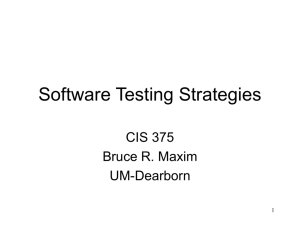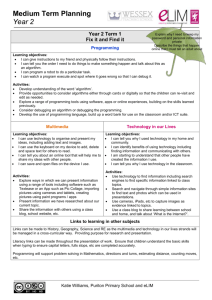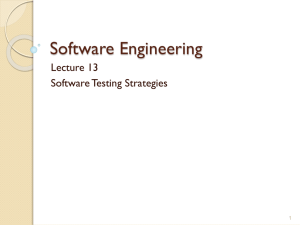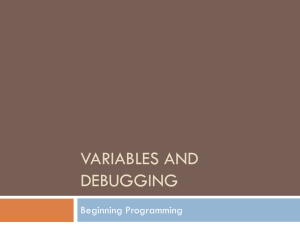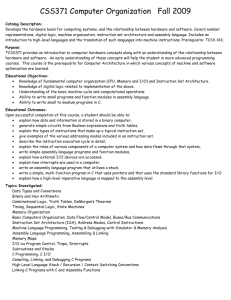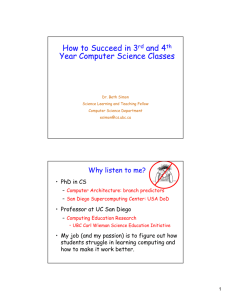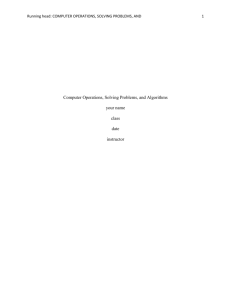ITEC 136 Business Programming Concepts
advertisement
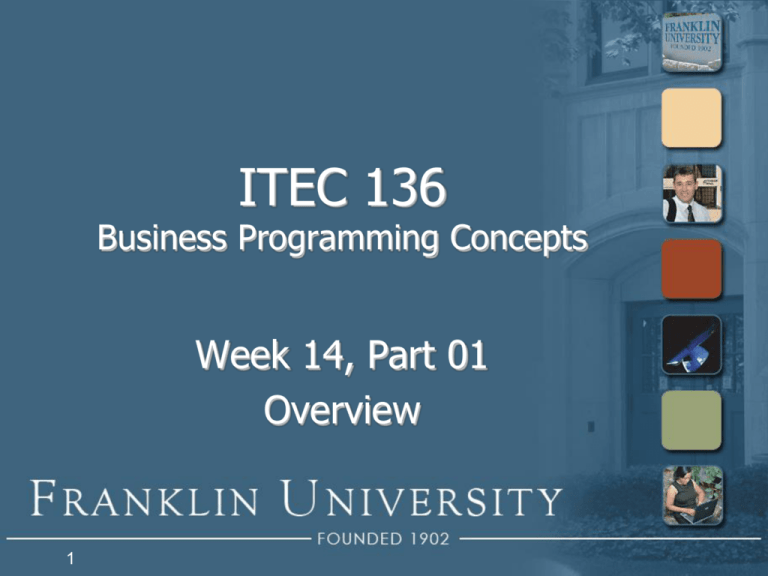
ITEC 136
Business Programming Concepts
Week 14, Part 01
Overview
1
Homework 9 Solution
2
Week 14 Overview
• Week 13 review
• What is an object? (three parts)
• State (properties)
• Identity (location in memory)
• Behavior (methods)
3
Week 14 Overview
• Week 13 review
• Custom JS objects
• Constructors
• this reference
• The prototype property of functions
• Benefits of object-orientation
• Coupling and cohesion (among others)
4
Week 14 Overview
• Week 13 review
• 3 of the 5 pillars of OOP
• Abstraction
• Encapsulation
• Composition (code reuse, 2 kinds)
5
Week 14 Overview
• Week 13 review
• Exception handling
• Detection and correction of errors are at
different places in code.
• Exceptions communicate between those
places and alter the flow of execution
• throw keyword
• try/catch/finally blocks
6
Week 14 Overview
• Outcomes
• Select necessary and sufficient test
cases.
• Use a debugger to examine a running
program.
• Correct runtime errors through a
debugger.
7
Week 14 Overview
• Outcomes
• Select necessary and sufficient test
cases.
• Use a debugger to examine a running
program.
• Correct runtime errors through a
debugger.
8
ITEC 136
Business Programming Concepts
Week 14, Part 02
Testing Concepts
9
Testing Concepts
• Testing in the SDLC
Requirements
Requirements
Deployment
Analysis and
Design
Implementation
Testing
Analysis and
Design
Testing
Maintenance
Implementation
10
Testing Concepts
• Validation vs. verification
• Validation: A comparison of the system
behavior against what the user actually
needs. “Have we build the right
software?”
11
Testing Concepts
• Validation vs. verification
• Validation: A comparison of the system
behavior against what the user actually
needs. “Have we build the right
software?”
Primarily the work of
business analysts and
designers. Critical to realworld software success.
12
Testing Concepts
• Validation vs. verification
• Validation: A comparison of the system
behavior against what the user actually
needs. “Have we build the right
software?”
• Verification: A comparison of system
behavior against the specification.
“Have we built the software right?”
13
Testing Concepts
• Validation vs. verification
• Validation: A comparison of the system
behavior against what the user actually
needs. “Have we build the right
software?”
• Verification: A comparison of system
behavior against the specification.
“Have we built the software right?”
14
Testing Concepts
• Validation vs. verification
Primarily the work
software
• Validation: A comparison
ofof the
system
and quality assurance
behavior against
what What
the most
user
actually
engineers.
people
think of when you say “testing.”
needs. “Have we
build the right
Our focus this week.
software?”
• Verification: A comparison of system
behavior against the specification.
“Have we built the software right?”
15
Testing Concepts
• Types of testing
• Unit testing: A function or object
designed to test the behavior of a
another function or object.
• Operates in isolation of other objects.
• Provide known inputs to check against
known outputs.
• Group together into a test suite.
16
Testing Concepts
• Test driven development
• If testing is good, then why not do it
continuously?
Clean up (refactor)
the design
Write a test case for
new behavior
Debug any
new test case
failures.
Run all tests
(watching new
test fail)
Write code to make
new test case pass
17
Testing Concepts
• Types of testing
• Integration testing: verifies the
behavior of larger groupings of
modules.
• Done after unit testing of each component
part, yet before system testing.
• Exposes interface, design problems
18
Testing Concepts
• Types of testing
• System testing: testing of the entire
system assembled from major
modules.
• Done after integration testing
• Load, security, stress, performance,
reliability, etc.
19
Testing Concepts
• Types of testing
• Acceptance testing: performed by
subject matter experts just prior to
release. Last chance for bug finding.
• Done after system testing.
• Sometimes called beta testing.
• Binary decision (go/no go for release).
20
Testing Concepts
• Types of testing
• Regression testing: re-running old
test cases after every bug fix to ensure
that the fix introduced no new bugs.
• Prevents cycling of bugs.
• Acts as a safety net.
• Permits refactoring (redesign of existing
code) while maintaining quality.
21
Testing Concepts
• Black- vs. white-box testing
• Black-box testing: treats the item
under test as a black box, providing
only inputs (both valid and invalid) and
checking outputs. Does not exploit
internal knowledge of how the code
works.
22
Testing Concepts
• Black- vs. white-box testing
• White-box testing: testing all paths
through the software using carefully
crafted inputs (both valid and invalid).
• Critical to achieve a high degree of test
coverage, i.e. the percentage of lines of
code exercised by the tests.
23
ITEC 136
Business Programming Concepts
Week 14, Part 03
Applied Unit Testing
24
Applied Unit Testing
• Unit tests must
• Be quick and easy to write
• Run in an automated way
• Provide value to the programmer
• Method
• Provide inputs
• Validate outputs
25
Applied Unit Testing
• How do we test this:
function absoluteValue(number)
{
if (number < 0)
return -number;
return number;
}
26
Applied Unit Testing
• How do we test this:
• Simple way:
function testAbsoluteValueFunction()
{
if (5 != absoluteValue(-5))
alert("failed test 1");
if (5 != absoluteValue(5))
alert("failed test 2")
}
27
Applied Unit Testing
• How do we test this:
• Simple way:
Advantages:
• Simple.
• Can be used for
regression testing.
function testAbsoluteValueFunction()
{
if (5 != absoluteValue(-5))
alert("failed test 1");
if (5 != absoluteValue(5))
alert("failed test 2")
}
28
Applied Unit Testing
• How do we test this:
• Simple way:
Advantages:
• Simple.
• Can be used for
regression testing.
function testAbsoluteValueFunction()
{
Disadvantages:
if (5 != absoluteValue(-5))
• Not easily reused for
alert("failed test 1");other kinds of testing
if (5 != absoluteValue(5))
• Too many alerts
alert("failed test 2")
}
29
Applied Unit Testing
• Building a unit testing framework
• Principles:
• Make unit testing easy
• Take away all the repetitive code
• Report errors succinctly
30
Applied Unit Testing
• Building a unit testing framework
var tests = new UnitTester();
tests.addTests({
testNegative : function() {
tests.assertEquals(5, absoluteValue(-5));
},
testPositive : function() {
tests.assertEquals(5, absoluteValue(-5));
},
testNonNumber : function() {
tests.assertEquals("NaN", "" + absoluteValue("x"));
}
});
tests.runTests();
31
Applied Unit Testing
• Building a unit testing framework
var tests = new UnitTester(); Expected answer
tests.addTests({
testNegative : function() {
tests.assertEquals(5, absoluteValue(-5));
},
testPositive : function() {
Actual answer
tests.assertEquals(5, absoluteValue(-5));
},
testNonNumber : function() {
tests.assertEquals("NaN", "" + absoluteValue("x"));
}
});
tests.runTests();
32
Applied Unit Testing
• Building a unit testing framework
function FailedTest(expected, actual) {
this.expected = expected;
this.actual = actual;
}
FailedTest.prototype.toString = function() {
return "expected: " + this.expected +
", actual: " + this.actual;
}
A failed test throws a
FailedTest exception
capturing how it failed.
33
Applied Unit Testing
• Building a unit testing framework
function UnitTester() {
this.allTests = new Object();
this.failures = [];
}
Compares
expected and
actual values.
UnitTester.prototype.assertEquals = function(
expected, actual) {
if (expected.equals && !expected.equals(actual))
throw new FailedTest(expected, actual);
else if (!(expected == actual))
throw new FailedTest(expected, actual);
}
34
Applied Unit Testing
• Building a unit testing framework
UnitTester.prototype.addTests = function(manyTests)
{
for (index in manyTests) {
this.addTest(index, manyTests[index]);
}
}
UnitTester.prototype.addTest = function(name, test)
{
this.allTests[name] = test;
Sets up test
}
functions to run.
35
Applied Unit Testing
• Building a unit testing framework
UnitTester.prototype.runTests = function() {
for (var index in this.allTests) {
if (this.allTests[index] instanceof Function) {
try {
Actually runs the test
this.allTests[index]();
functions
}
catch (exception) {
this.failures.push(index + ": " + exception);
}
}
}
alert(this.makeResultsString());
}
36
Applied Unit Testing
• Building a unit testing framework
UnitTester.prototype.makeResultsString = function()
{
var str = "";
for (var index in this.failures)
{
str += this.failures[index] + "\n";
}
if (str == "")
Produces the results.
return "All tests passed.";
return str;
}
37
ITEC 136
Business Programming Concepts
Week 14, Part 04
Selecting Test Cases
38
Selecting Test Cases
• Test coverage
• Making sure that all parts of your
program are exercised by the test
cases.
• Every direction of nested if/else structures
• Every possible case in a switch statement
• Every possible way a loop can be run
• Never iterating (pre-test only)
• Iterating once
• Iterating many times
39
Selecting Test Cases
• Test coverage
• Making sure that all kinds of data are
tested
• An “expected” test case
• “Corner” cases
• Illegal inputs
40
Selecting Test Cases
• Test coverage
• Ex: calculating square roots
• Expected inputs: numbers from [1…n]
• Corner cases: 0, [0…1]
• Illegal inputs: negative numbers
41
Applied Unit Testing
• Try it:
• Write test cases using the testing
framework to determine if your
merge() function (which merges two
separately sorted arrays) works on
many different data sets.
42
Applied Unit Testing
• Try it:
• Write test cases using the testing
framework to determine if a sorting
algorithm actually sorts arrays.
43
Applied Unit Testing
• Try it:
• Write a function that builds a
histogram table at 10% intervals (i.e.
given an array of data in the range [0,
100] output an array with 11 “buckets”
containing the count of elements that
fall in those buckets).
• Write tests to verify that it works.
44
ITEC 136
Business Programming Concepts
Week 14, Part 05
Debugging Tools
45
Debugging Tools
• Old school approach
• Logging: debugging statements placed
strategically in program code.
function log(div, message) {
document.getElementById(div).innerHTML +=
message + "<br />";
}
// then later...
if (debug == true) {
log("debug", "Got to here");
}
46
Debugging Tools
• New school approach
• Logging: use the built in Firebug
logging console!
console.log("This is a log message");
console.info("This is an info message");
console.warn("This is a warn message");
console.error("This is an error message");
47
Debugging Tools
• New school approach
• Logging: use the built in Firebug
logging console!
console.log("This is a log message");
console.info("This is an info message");
console.warn("This is a warn message");
console.error("This is an error message");
48
Debugging Tools
• Debuggers
• Programs that allow you to examine
the state of another running program.
• Built in to the IDE in which you program
• Stop your program at a particular point
(breakpoint)
• Inspect the contents of a variable (inspect or
watch)
• Step through a program as it executes (step
into, step over, step out).
49
Debugging Tools
• Typical debugging session
• Set a breakpoint in your code just prior
to where you think a problem is
occurring (i.e. on the line just ahead of
the one in an exception’s stack trace).
• Run the program in debug mode, and
the program will stop just ahead of the
crash
50
Debugging Tools
• Typical debugging session
A breakpoint
• Set a
set at line 80.
breakpoint in your code just prior
to where you think a problem is
occurring (i.e. on the line just ahead of
the one in an exception’s stack trace).
• Run the program in debug mode, and
the program will stop just ahead of the
crash
51
Debugging Tools
• Typical debugging session
• Examine the variables at that point to
determine what may have gone wrong.
Use the watch or inspect features.
• Step forward through the program to
examine how the state of objects
change as the program is executing
line-by-line.
52
Debugging Tools
• Typical debugging session
• Examine the variables at that point to
determine what may have gone wrong.
Use the watch or inspect features.
• Step forward through the program to
examine how the state of objects
change
as thedisplays
program is executing
The watch window
the names and values of
line-by-line.
the local variables in the
function
53
Debugging Tools
• Typical debugging session
• Step into – if on a line with a function
call, starts debugging that function,
otherwise just executes the next line
• Step over – if on a line with a
function call, calls the function (but
doesn’t debug it), otherwise just
executes the next line.
54
Debugging Tools
• Typical debugging session
• Step out – runs the current function
to completion, resumes debugging at
the point at which the function was
called.
• Continue – runs to the next
breakpoint.
55
Debugging Tools
• Typical debugging session
Step into
Step out
• Step out – runs the current function
to completion, resumes debugging at
the point at which the function was
called.
Continue
• Continue – runs to
the next Step over
breakpoint.
56
Debugging Tools
• Firebug demonstration
• http://encytemedia.com/blog/articles/2006/05/12/a
n-in-depth-look-at-the-future-of-javascriptdebugging-with-firebug
• http://www.digitalmediaminute.com/screencast/fire
bug-js/
57
Questions?
58
Next Week
• Last class!
• Final exam!
59
ITEC 136
Business Programming Concepts
Week 14, Part 06
Self Quiz
60
Self Quiz
• What is the difference between
validation and verification?
• Name the five different types of
testing in the SDLC.
• Compare and contrast black-box and
white-box testing.
61
Self Quiz
• What is the advantage of a unit
testing framework over some ad-hoc
approach?
• Write a function “isSorted” that
returns true if the array given as a
parameter is sorted, and false
otherwise.
62
Self Quiz
• Write a thorough set of test cases
for isSorted.
• Describe the process of debugging
using a debugger.
• Describe the process of debugging
using a logging facility.
63
ITEC 136
Business Programming Concepts
Week 14, Part 07
Upcoming deadlines
64
Upcoming Deadlines
• Due April 13
• Homework 12 (optional)
• Lab 4
• Reflection paper
• Final exam
65
